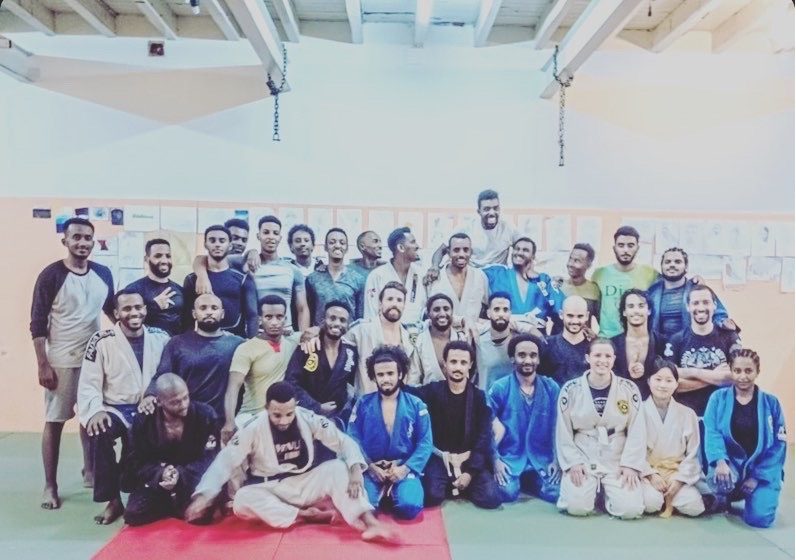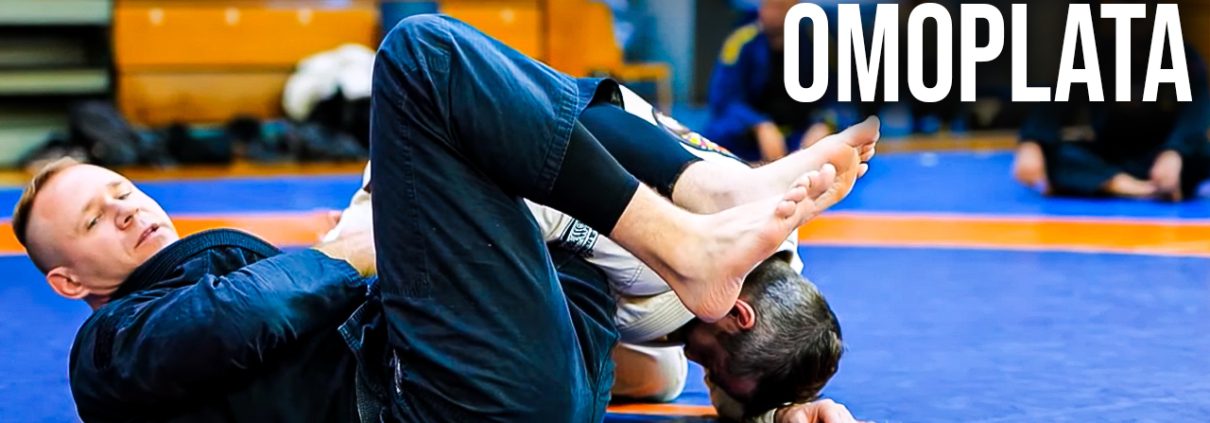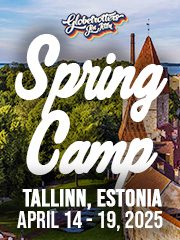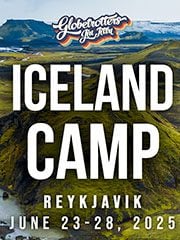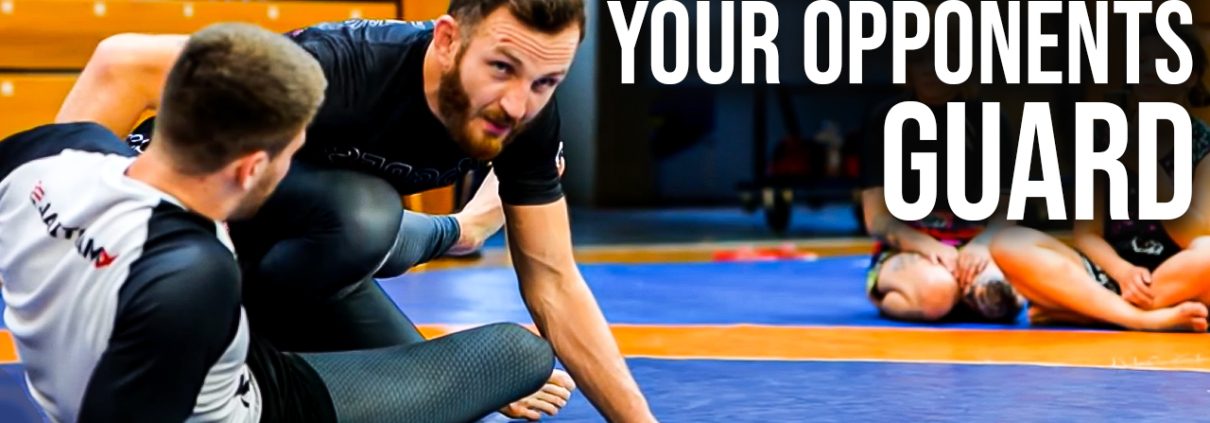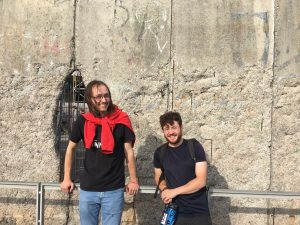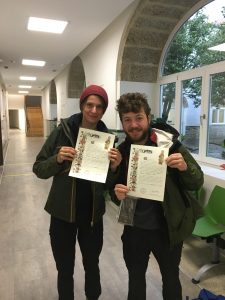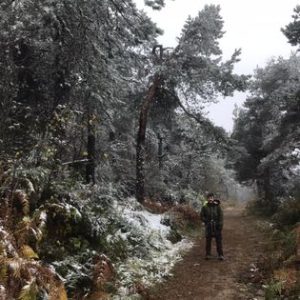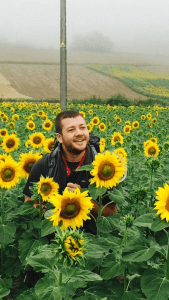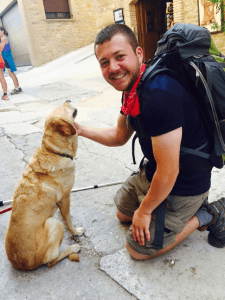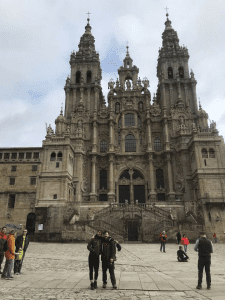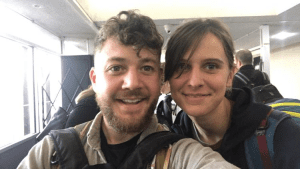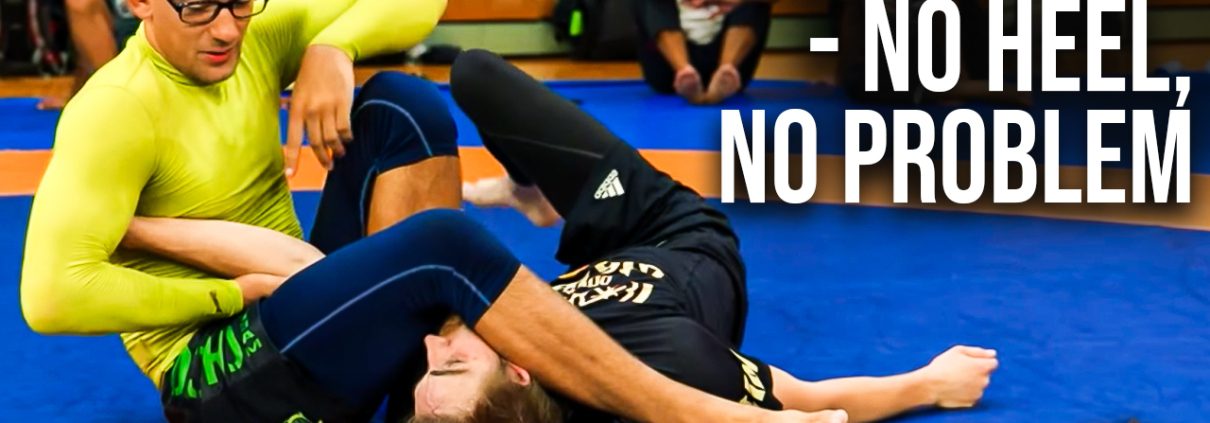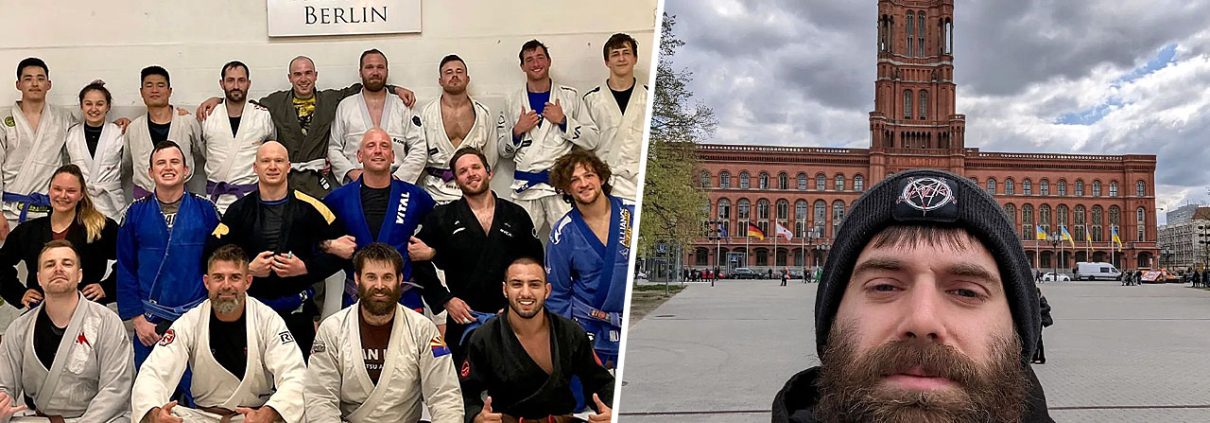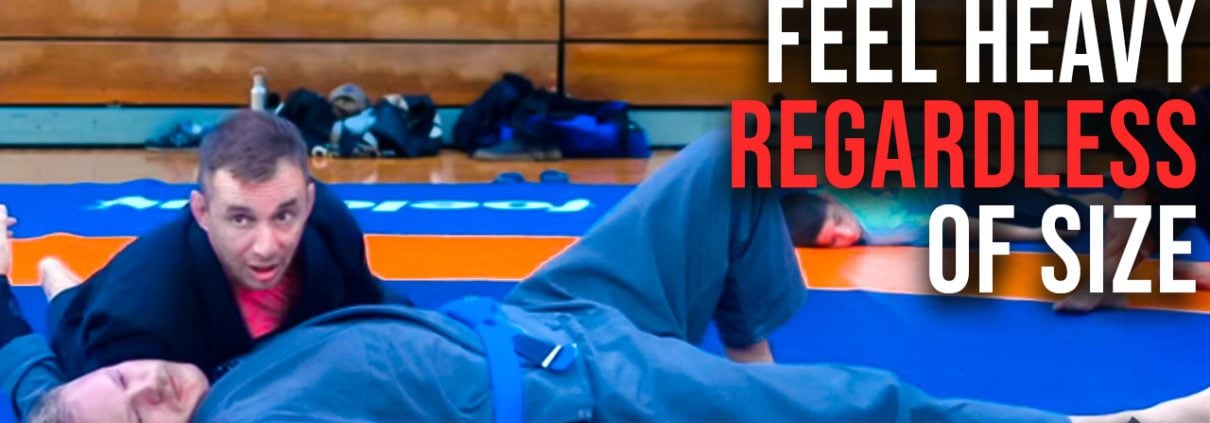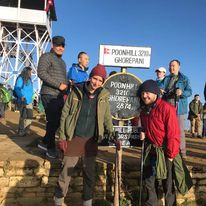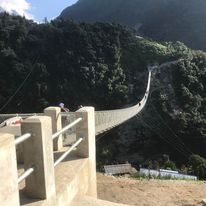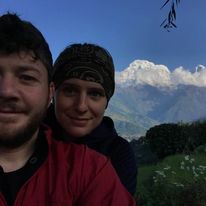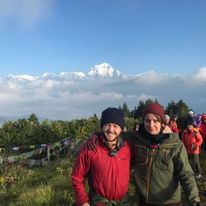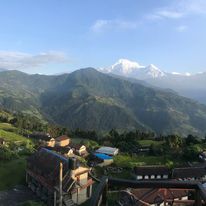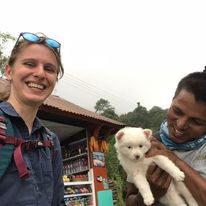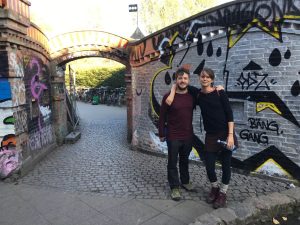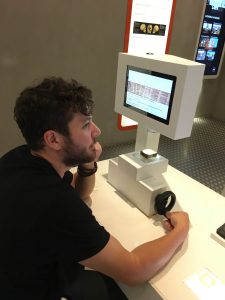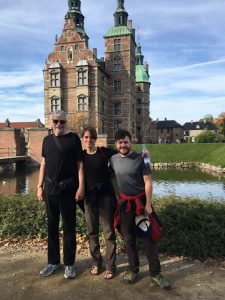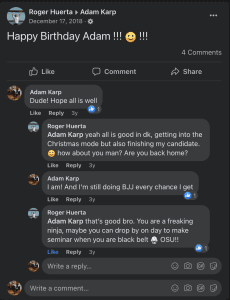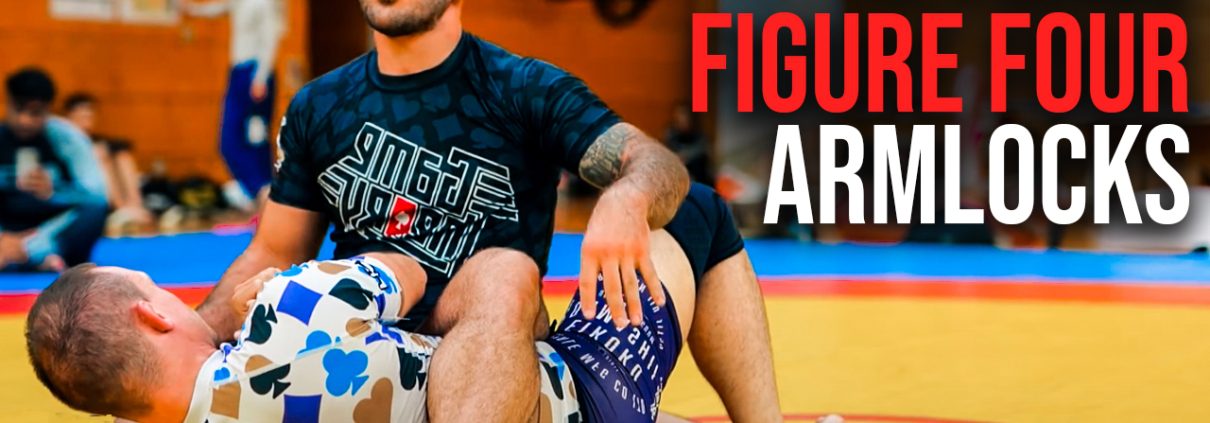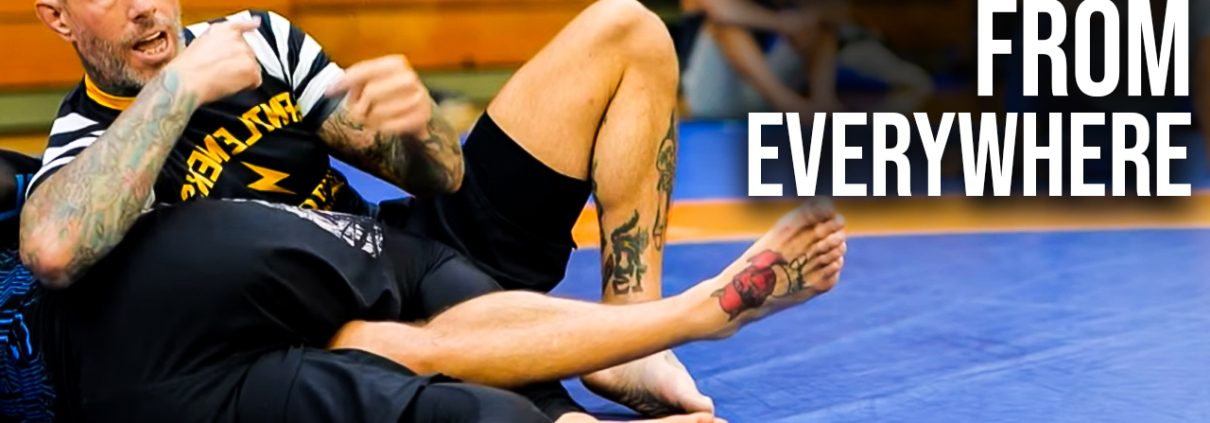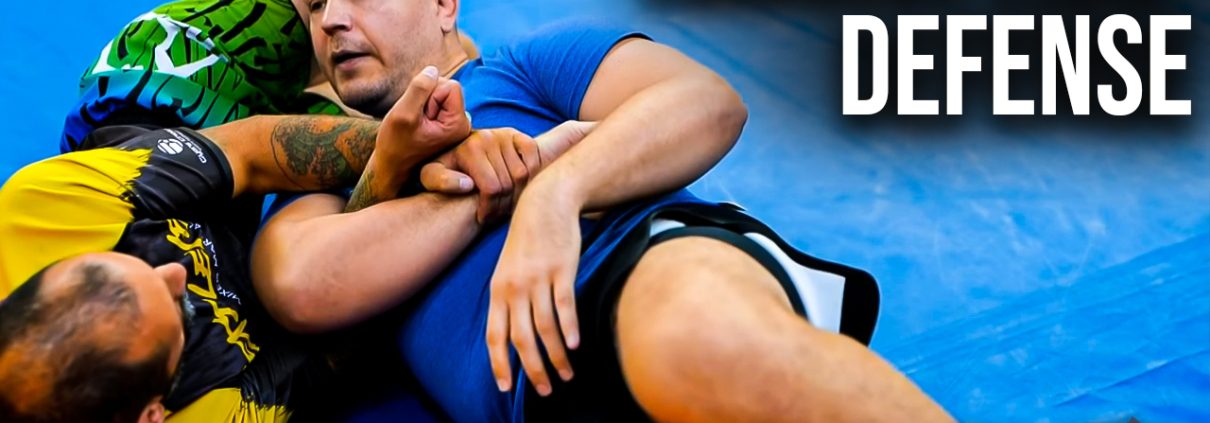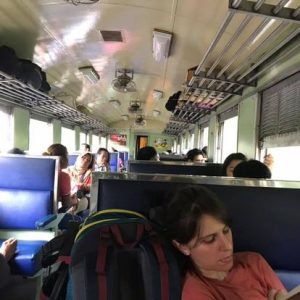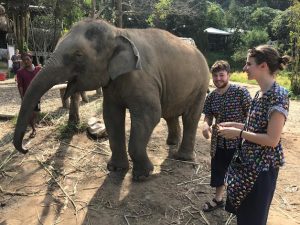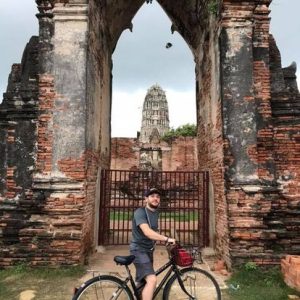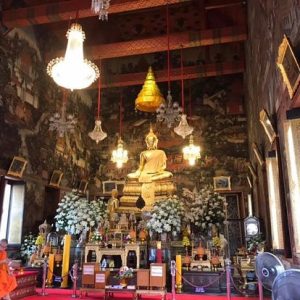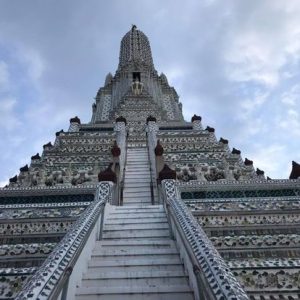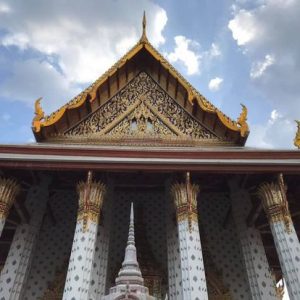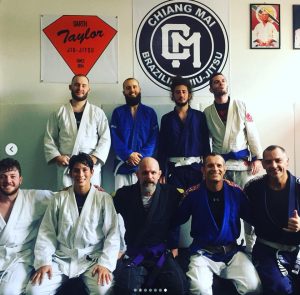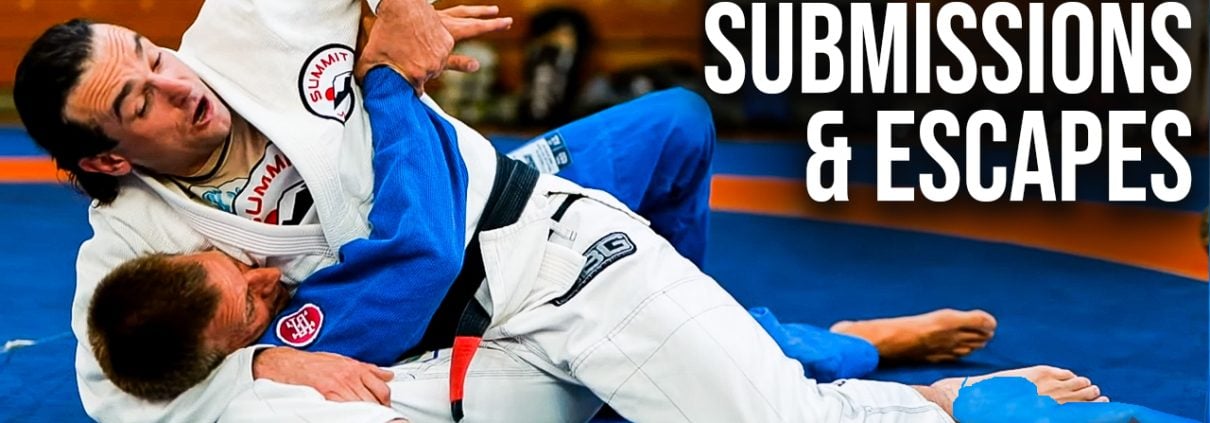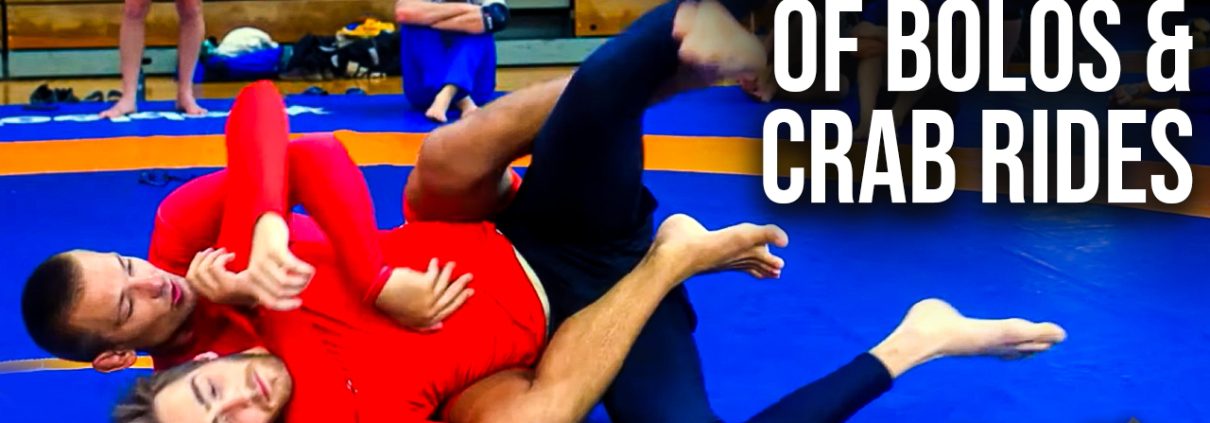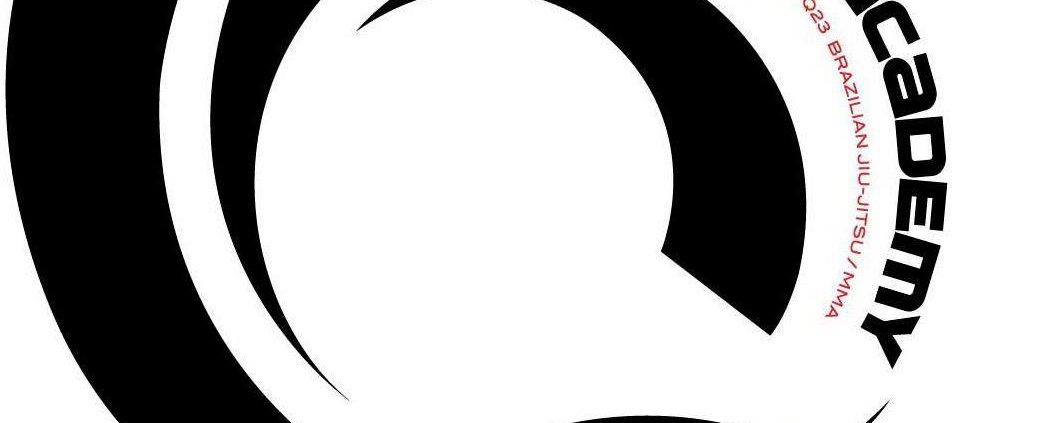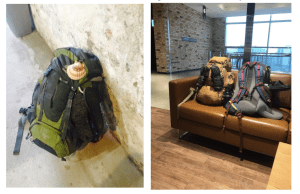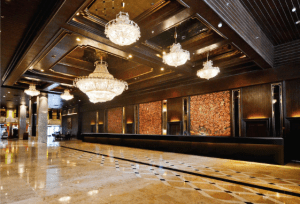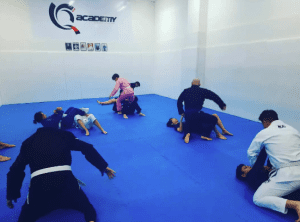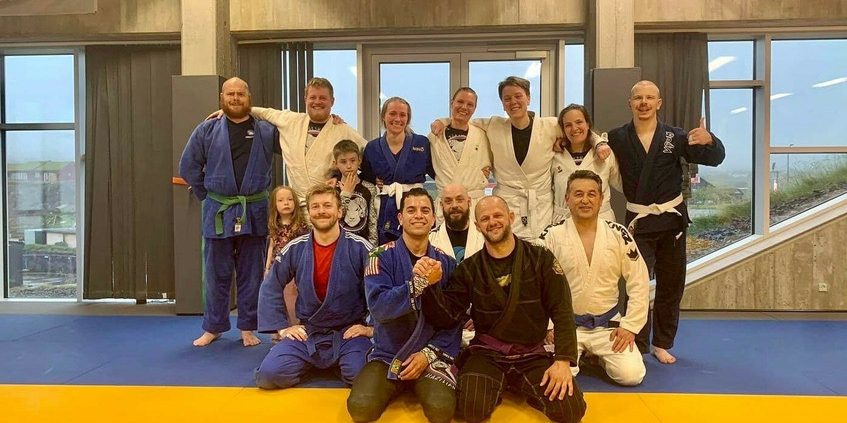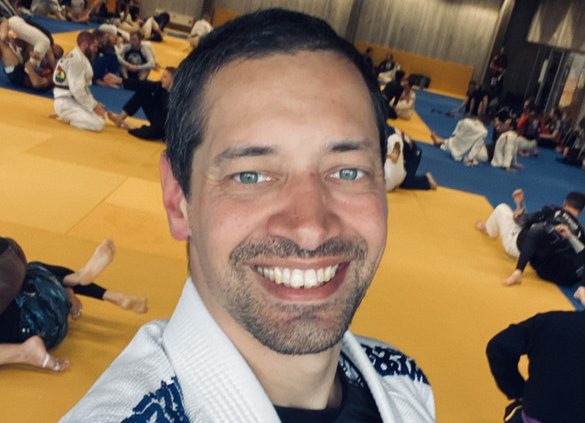Archive for month: October, 2022
Trekking, the Camino and How the BJJ Globetrotters Network Brought Me Home
Dust Mop Jiu Jitsu: The Expat Files: Chapter Five: Boston BJJ-Newton, Massachusetts
-On focusing on the journey instead of the destination and the importance of being a beginner
–
This is Chapter 5 of what I’m calling the Expat Files. If you want to know more about what this project is, you can read more about it in the first article here.
–
After Denmark, Rachel and I made our way to Germany, Spain and Portugal. By the end of our four month journey, we had explored mountains, tried surfing and obtained official documents absolving us of our sins (Neither of us are Catholic, but it can’t hurt). Each place was amazing but we had a special mission for Spain: the Camino de Santiago.
I’ve previously written about my love for trekking. Living out of a bag and only eating what you can carry gives you a simple daily structure . For the Camino:
| 7am: | Wake up, roll up your sleeping bag, lace up your boots, wolf down a pastry, slam back an espresso and start walking |
| 9am: | Stop for second breakfast |
| 9:30 am: | Keep walking |
| 1:00 pm: | Lunch |
| 1:30 pm: | Keep walking |
| 3 or 4 pm: | Find your hostel, claim a bunk bed, take shower and a nap |
| 5 pm: | Get dinner with some strangers and have the best conversation of your life |
| 8pm: | Bed |
It’s a hiking trail that’s like no other. You walk over the pyrenees, through the desert and then to the ocean. As a pilgrimage, these different parts of the trail have meanings. The first part, over the mountains, is good for the body. The second part, the Meseta, is devoid of scenery and it forces you to turn inward and examine your mind. The last, toward the cathedral of Santiago de Compostela, is for the soul.
Three years prior, I had started the Camino on my own. The whole thing takes six weeks, but in 2015, I only had three. I remember agonizing at the time about what I should do. Should I take a bus to the last bit? Perhaps I could skip the meseta. Maybe I could rent a bike.
I had fallen in with a group of hikers who gave me different advice. My assumption was that I would not be able to ever come back to Spain so I needed to get to Santiago now. I’ll never forget the conversation I had with this older French dude named Jerome.
Jerome: Ah so you will coupé (cut it) with a bus?
Me: I’m considering it
Jerome: But you will ruin it! Just walk to where you can and come back. You will see, it’s amazing! It will be just as you left it!
Me: But I’ll never be able to come back!
At the time, I was annoyed with him, but he was totally right. The best part of the Camino is starting it and looking forward to the journey. I remember meeting people who skipped the first few days so that they could make it to Santiago. I actually felt sorry for them. Like Jerome said, being a beginner is the best part. In contrast, the end of the Camino, in 2018, was totally sad. The hope that we would reach Santiago is what got me out of bed each morning, now we didn’t have that. Rachel and I actually labeled it Post Camino Depression. But the beginning, the bonding with other travelers, the arduous hikes, is what made it special.
After the trail, we flew to Boston from Barcelona. The cool thing is that we flew to Korea out of Los Angeles so since leaving the states, and then went to Europe and finally to Massachusetts. That meant that since leaving the USA for Ulsan in 2017 we had actually circumnavigated the globe.
It had been six weeks since I had trained any Jiu JitsuBy the time we arrived in the states. Luckily I knew exactly where I could go. Boston Brazilian Jiu-Jitsu Academy caught my eye years before going to Korea, but I was always too nervous to go in. But here I was, six months into training. I had already been brave enough to start the process and continue it in other people’s gyms. This would be my first foray into establishing myself as a BJJ practitioner in America. Interesting how for some, the globetrotters network brings them gyms all over the world. For me, it literally brought me home.
All that confidence crashed after I stepped onto the mats and saw a wall of people wearing black belts. At Ulsan Fight Gym in Korea, my instructor was a purple belt. In Thailand, I met black belt instructors but nobody else was at that level. This was the first time I saw black belts learning from black belts. To this day, Boston BJJ is the most black belt heavy gym I’ve been to.
The class was at 7 AM. I dragged myself out of bed to get there. In late November, a few guys were freezing at the door. The instructor, John, finally showed up late and herded us inside. Since none of the guys complained, I figured this must be normal. Nobody even noticed me enough to find out if I was a member. They just rushed on the mats and started a twenty-five minute game of King of the Guard.
If you haven’t played it, King of the Guard works like this:
- Everyone pairs up with one person being put in guard
- The person in guard has to pass
- If he makes it, he stays down and somebody new comes to him
- If he doesn’t he finds a new person
- The person who has guard needs to sweep or submit
- If he sweeps or submits, he stays where he is
- If he gets passed, he gets up and finds a new person
I got swept and submitted less than 30 seconds with each person. It wasn’t even close. These guys were toying with me like a cat with a ball of yarn.
One guy showed up late. He walked slowly, had wrinkles under his eyes and looked frail. He made the loudest old man noises as he stretched. Once he was on the mats, I walked over to him and he looked deep in my eyes. He spoke extremely slowly to me. “Listen. You are young. I am in my fifties. Okay? Be aware of our age differences and that I don’t heal as fast. OKAY?” Five seconds later I was in the tightest armbar I’ve ever felt.
I had never felt such a gap in skill. In Korea most people were beating me, but it didn’t feel like a shutout. This felt like being in a tornado. I got swept and submitted by everyone in less than a minute. One guy put his hand over my mouth and nose. I remember asking him if it was a legal move. “…no. Just something we like to use for newcomers.”
–
It’s not that black belts are inherently more athletic than everyone else. When you start Jiu Jitsu, you’re not used to moving around on the floor. The movements don’t have access to potential energy. Once your body gets used to that, you have a major advantage over somebody who isn’t. Think about what it’s like to run a race against somebody who doesn’t even know how to walk.
With more advanced people, the intimidation comes more from the sense that they always seem to know something you don’t. Now think about how those people are with each other, how much misdirection they learn to get what they want against somebody who sees their moves coming a mile away. It’s this learning curve that gives Jiu Jitsu its mythic status as the martial art for the little guy.
BJJ people love comparing jits to chess. “You get better by rolling with people who are better.” But these guys were honestly too far out of my league. I would get home feeling like I had never understood anything. They rarely even taught techniques unless the instructor felt like it. The schedule said they had a fundamentals class. I had not yet been to a gym that had separate classes for beginners. A prideful part of me didn’t want to think of myself as a beginner but I knew I had to give it a shot.
I actually ended up really liking the beginner’s class. There’s a split in the Jiu Jitsu world over how much time should be devoted to warm ups. Some feel it robs you of valuable time you could be focusing on Jiu Jitsu. But our instructor, Alex, led them in an interesting way. He would say “20 jumping jacks.” First he would count to ten then we would count in unison from 11-20. When you are new to a gym and a group of people, yet you find yourself moving in the same way as them, you inevitably feel a connection. That team feeling is what was missing from the class with all the Black Belts. Those guys weren’t trying to be exclusive, but the reality is they had all probably known each other for at least 10 years. Just like on the Camino, it’s easier to connect with people who are on the same leg of the journey as you.
Alex also explained some of the basic moves in a way that made me realize I had never understood them back in Ulsan. Alex’s class structure helped me feel like I did in Ulsan, that I was learning something new each day. (He’s also a good writer. Check out this article he wrote about Anthony Bourdain and BJJ or his sci-fi series on MMA. He writes about a dystopian world where wars are fought through MMA matches. The practices he describes in the book actually describe the kinds of methods he used at Boston BJJ).
I spent every day for almost a month at either the advanced or fundamentals class. And I I learned a lot. I like to think I was getting better, but I was more likely learning how to identify what I had been previously doing wrong. Here again, I found it interesting to be around such advanced folks. The advice I got from black belts was great, but the advice I got from blue and purple belts was honestly more helpful. Those were the folks that were most recently in my shoes.
Boston BJJ ended up becoming a second gym to me. I would soon move to Burlington, Vermont. My coach there had gotten his black belt from the Boston BJJ head coach, Roberto Maia, which meant I didn’t have to pay for drop ins. I would train there whenever I was visiting my parents or working in the area. I always looked forward to it as well. I still got crushed by the black belts each time, but I started learning from them as well.
Unfortunately, I think they took a hit during the pandemic. I’m not sure the full story, but all I know is that they don’t exist at that location anymore. I hope they get back on their feet soon and I can see those folks again. Since they closed, I’ve had to look for other gyms to train when I visit my folks. At a few places, I’ve seen some of the Boston BJJ diaspora. I always approach them and commiserate about how much we miss the academy.
The folks I walked with on the Camino DeSantiago will always have a special place in my heart. But similarly, the black belts who crushed me, the blue belts who mentored me and the white belts who grew with me will forever be a part of my BJJ journey.
The Dust Mop Takeaway:
Part of the reason for me writing this blog is to reflect on what it feels like to be a white belt after so much time. When I started BJJ, I remember hoping that I would make it to blue belt before I got to the states. But there’s something comforting about being a white belt. Nobody expects anything from you so it’s a win-win scenario. If you do poorly, nobody looks disappointed, and if you do well, everyone seems impressed (or annoyed depending on who you roll with). It’s honestly something that I think I will miss if I get promoted, that feeling like I’ve got nothing to lose.
At Boston BJJ, I learned to love being a beginner. I got the mindset that there’s always more to learn. Just like being on the camino, there’s always more trail to cover. It’s what inspires you to wake up at 7am, lace up your boots and get walking right away. For jits, it’s what inspires me to get to training five days a week.
–
My goal is to visit 100 gyms! If you ever want me to visit yours and write about what it’s like to learn from you, feel free to reach out at Du*************@***il.com.
If you want to read my articles as soon as they’re published, you can follow me here.
Episode 19: How David from Canada used Matsurfing to go on an epic trip through Europe
Podcast: Play in new window | Download
Subscribe: RSS
Matsurfing is couchsurfing style network for Jiu Jitsu travelers and it is—unknown to many—actually how the idea of BJJ Globetrotters started out in the very beginning. It’s a little corner of our community that is less exposed but widely used. David Bruun from Canada tells his story about how he used the network to travel through Europe on an epic adventure.
Treat Everyone Like They Will Be A Black Belt
Dust Mop Jiu Jitsu: The Expat Files: Chapter Four: CSA-Copenhagen, Denmark
-On fitting in, reconnecting to nature and BJJ as a communal endeavor
–
This is Chapter 3 of what I’m calling the Expat Files. If you want to know more about what this project is, you can read more about it in the first article here.
–
After Thailand, Rachel and I went to Nepal. I found literally no traces of BJJ existing there. We spent two weeks there trekking and breathing fresh air. This was a detox we sorely needed. Ulsan, the city in Korea, where we had lived, was incredibly crowded. Most nights we had to keep our curtains closed to keep out the neon lights. The first time we slept in our apartment, we heard the screaming cries of a stumbling drunk. But for two weeks in Pokhara, we woke up and saw mountains for days. Missing Jits was honestly worth it.
Rachel’s parents are both academics. Her mom gets consulting jobs all over the world to help museum’s with their exhibits. It’s really impressive because she can tell you all about the cafeteria in each one and what you should be ordering. Right after leaving Nepal, we met up with them in Copenhagen where she was working with the natural history museum.
Copenhagen is a beautiful city with beautiful people. A little…too beautiful maybe. Let me explain. Rachel and I had spent a year where we were, quite obviously, not Korean. People just automatically knew to switch to English when they saw us, or, at the very least not try speaking Korean. We thought that going to Europe would be the end of that but…no. People there all seemed to be a foot taller than me and incredibly stylish. We were planning a backpacking trip in Spain so we only had hiking clothing. But as the Danes rode their bikes through the streets, they all seemed like something out of a Gap commercial only wearing black or charcoal. I swear I saw a woman riding a bike with a scarf on where it waved behind her like a flag. Not a care in the world. No worry, for example, that it would turn into a game of tug of war between her neck and the bike chain. I think most people could tell without speaking to me that I wasn’t a local. I’m too short to be a Dane.
The food was amazing, if not a shock to the system. Good bread is hard to come by in Korea. Most apartments I saw in Ulsan didn’t even have an oven. And cheese options were limited as well. But here we were eating smoked salmon on the richest cheeses and the hartiest breads we’ve ever encountered. I lost a lot of weight in Korea not having access to that stuff. I gained it back in Denmark.
For Jiu Jitsu, I knew exactly where I wanted to go. CSA, home of the BJJ Globetrotters! I knew that was where the whole project of politics-free Jiu Jitsu started. I made sure to get myself over there. One morning, I hopped on what seemed like the world’s most advanced bikeshare and made my way to the class. (Biking in Denmark is awesome, and there are good views everywhere.)
When I arrived I saw a building that looked huge. I knew it couldn’t be 100 percent dedicated to BJJ. It turned out to be a community center with art studios, education offices and gym space. The hallways looked all the same and I wasn’t able to find CSA. I even stopped by a Karate dojo in the building wondering if they shared the mats with them.
Finally, I found the place. They didn’t have a bathroom in the gym space so I went down the hall. It didn’t have a gender on the sign so I went in and saw a room full of doors, each leading to a private toilet. In the middle was the sink with the soap. I went into a toilet stall and changed into my rash guard. When I came out, I saw a woman washing her hands and I was taken aback. Up until that point in my life, I had literally never seen a public restroom set up that way. Why don’t we do that in the US? It would probably save space and make some culture war issues moot. It’s honestly seeing things like Danish bathrooms that make travel worth it.
Roger Huerta was the instructor for the day. He said he was just filling in for the jiu jitsu instructor. Although Adam Shahir Kayoom at Q23 is an MMA fighter, I had never had a class taught by someone who mostly taught striking. But I was intrigued. MMA is an interesting part of the jiu jitsu journey. Before doing BJJ, I had never been interested in the sport at all. But as I learned more about the history of the UFC and the way it brought grappling to the spotlight, I started to gain more perspective. The first UFC I ever made a point to watch had just happened the previous week. It was the infamous UFC 229: Connor McGregor vs. Khabib Nurmagamedov. I had kept my eye on the media hype over it because it felt like the ultimate grappler versus striker setup. I had felt somehow vindicated when Khabib played with McGregor like a cat place with a ball of yarn. My discipline was legit enough to win.
Despite my budding interest in MMA, I was still unsure of what a BJJ class taught by a striker would entail. Roger was the nicest guy. It was me and three Danish guys. I remember one of them being super tall and the other guy being very large. I’ll never forget grappling with the latter and not being able to secure the ever-illusive triangle choke. He said, “Ya don’t worry about it. My neck is too fat. Everybody is telling me so.”
Most Danes I met spoke English better than me so their fluency didn’t really surprise me. Still, what surprised me was that the class was taught entirely in English. It made sense in Thailand since most people were expats. But I still can’t figure out if that’s how they normally do it or if they just switched as soon as I got in the class. Come to think of it, to this day (4/5/22), the last time I’ve been to a Jiu Jitsu class not taught in English was in Korea.
Roger turned out to be a really fascinating person. After the class we had a conversation about life, fulfillment, mental health and training that covered a lot of ground. It felt like the kind of talk you have with a friend over a series of drinks but here we were sober, exhausted and getting into all of life’s mysteries. A few months later, he messaged me on my birthday. Everyone does that on facebook, but his last comment meant a lot to me. He was the first person to suggest that I could someday become a black belt.
If you haven’t seen it, there’s an amazing ted talk called lollipop moments. In it, Drew Dudley advocates for thanking people for offhand comments that make us feel special. Even, or especially, when they can’t remember it themselves.
“We celebrate birthdays, where all you have to do is not die for 365 days. Yet we let people who have made our lives better walk around without knowing it.”
Roger might have just been being nice by suggesting that I might one day become a black belt. But my theory is that longevity in this sport has to be a communal endeavor. The common estimate is that it takes ten years to become a black belt. How can you possibly do that alone?
You need people to care that you stick with it and you need to be invested in their success and longevity as well. People care that I show up on the mats. I have to remember that and care that they show up as well. Treat everyone like they will be a black belt and you might find yourself becoming one faster.
So, this one’s for you Roger. Your prediction was a major lollipop moment.
–
My goal is to visit 100 gyms! If you ever want me to visit yours and write about what it’s like to learn from you, feel free to reach out at Du*************@***il.com.
If you want to read my articles as soon as they’re published, you can follow me here.
Overcoming the Disappointing Part of Travel at Chiang Mai BJJ
Dust Mop Jiu Jitsu: The Expat Files: Chapter Three: Chiang Mai BJJ-Chiang Mai, Thailand
-On the disappointing nature of traveling without a purpose, the connection between BJJ and Trekking and the ways that Jiu Jitsu lets you borrow another life for a day.
–
This is Chapter 3 of what I’m calling the Expat Files. If you want to know more about what this project is, you can read more about it in the first article here.
–
Imagine you take a trip to Berlin. You’re there for three or four days. You see the Wall, Checkpoint Charlie, a number of museums and eat as many pretzels and brats as you can handle. By the time you leave, you ask yourself, “Did I really see Berlin?” You likely haven’t even scratched the surface. There’s always a sense that you could have done, seen or experienced more. It’s the disappointing part of travel that I rarely see mentioned.
It’s one of the reasons I love trekking. You always have a goal: get to the next campsite. On trail, you meet amazing people and gain an intimate relationship with the landscape. As long as you made it, every other experience is a bonus.
Rachel and I had no real direction in Bangkok. It had been less than a week since we left Korea so we had no plans or goals. It was hard to see a purpose for us really being there except to say we had been in a new location. We felt aimless as we headed to our next location.
We took a night train north to Chiang Mai. It’s one of those awesome romantic things that you hope to be able to do at least once in your life. You walk through your carriage and everyone gets their own bunk bed with curtains. To help us sleep, we took the most powerful drowsy pills the Korean medical system can give you. “If you’re flying,” Rachel’s doctor said, “only take them once you’re on the plane! People take them in terminals and miss their flights.” They hit us like bricks. We slept like babies. But we really didn’t know what they were. Prescriptions in Korea often just came in plastic bags. You would walk away from a pharmacy feeling like you’ve collected your fix from a drug dealer. It was only a month after leaving Thailand that we realized they were probably opiates.
Bangkok is loud, overwhelming and fairly polluted. Chiang Mai, on the other hand, is this beautiful, small city centered around a number of Buddhist temples. Definitely a more relaxed atmosphere. We tried to be as chill as possible. We saw the sites, went to a Muay Thai fight, got a couples massage and took a day trip to an elephant sanctuary.
These experiences were fun but there was still the Berlin problem. How could I have a goal that would allow me to “accomplish” the city? It’s harder in urban settings, there’s too many options.
Being from New England, I’ve been to New York City several times. My favorite time going there was for a job interview. I woke up early like a New Yorkers, hit the subway and felt like I blended into the rhythm of the city. In Bangkok, I realized I had felt that way training at Q23. Figuring out the transport, adhering to the Thai schedule and doing the same drills as everyone else gave me the impression that I was borrowing another life instead of simply being a tourist.
I used the BJJ Globetrotters network again to find Chiang Mai BJJ. Even before arriving at the studio, I could feel my new tourism strategy working. Getting there by foot allowed me to orient myself to the city. Also, I felt like I had a reason to be there.
Unlike the gym in Bangkok that was in a five star hotel, this one was on the second story of an apartment building. I went to two classes and both times felt a specific sensation: a rented, clean jiu jitsu gi hitting a body that’s already sticky with sweat. The humidity in Thailand is something else.
Everybody there was so chill! I had more time there to meet people and talk with them. That’s something that didn’t happen much in Korea. Most people in the gym were expats. Both times I rolled with this nice British dude, I think his name was Daniel (second from the right on the top row). I remember he was planning on trekking in Nepal, where Rachel and I were headed next. We rolled and I almost put him in a triangle choke, but it would honestly be another year before I made that work on anyone. Another guy was also from the UK but competed a lot in Israel. Hearing him talk about it, I was intrigued and intimidated. I remember thinking of the competition I pulled out of in Korea.
The guy to the left of Daniel, Kia (I think), was trying Jiu Jitsu for the first time. Bryan, the instructor, surprised me by pairing me up with Kia and asking me to explain some basics. I was thrilled! I had never taught anybody anything in BJJ before.
He made it very clear that he was just trying and didn’t want to commit to anything. But as I explained the difference between being in guard and passing it, his eyes widened in amazement. I’ve explained the same concept several times over the years, it never gets old seeing the gears turn in people’s heads. I sometimes wonder where Kia is now and if he continued.
The expats in Chiang Mai were different. In Bangkok, the jiu-jitsu folks I met had been there for a long time. They had stable jobs and were married. But most people in Chiang Mai were just passing through on their way to mountains and other adventures. This was another important thing for me to see on my jiu jitsu journey.
Previously, I had the impression that if you want to train, you really need to have a nine-to-five and carve out your schedule. But these folks trained in between, and sometimes as a part, of their adventures. Because of that you heard about places that they had trained before, either in their home country or other places.
I had only previously experienced that on trekking trails. You share fires, campsites and beers with fellow hikers. There’s a natural comradery in everyone working toward a common goal. You know the trail will be over in a few days. You want more experiences and friendships like this and you ask your fellow travelers where else have they been or where they want to go. The imagination goes wild and you see the world as one big trail. Leaving Chiang Mai BJJ, I saw the opportunity to learn grappling, experience culture and share the journey with folks all over the world.
I had never connected my love for trekking with my love for Jiu Jitsu. There’s a clear goal, a feeling of slow but constant progress and an affinity for people that are on the same journey. I once met a Rabbi who defined love as just that: people working toward a common goal.
The Dust mop Takeaway:
Getting the opportunity to teach Oren was what I’ll remember the most. It was the first time I taught anybody else in BJJ.
For techniques, I remember my roll with Daniel. Bryan saw us and casually said, “you’re not going to get a triangle choke going that direction.” My body had pivoted the wrong way. I remember him as I watch newer folks struggle to configure themselves.
–
My goal is to visit 100 gyms! If you ever want me to visit yours and write about what it’s like to learn from you, feel free to reach out at Du*************@***il.com.
If you want to read my articles as soon as they’re published, you can follow me here.
What It’s Like to Use the Globetrotter Network for the First Time: Q23 Bangkok
Dust Mop Jiu Jitsu: The Expat Files: Chapter Two: Q23-Bangkok, Thailand
On the pleasures of living out of a bag, trusting your commitment to BJJ and overcoming the fear to drop-in to another academy.
–
This is Chapter 2 of what I’m calling the Expat Files. If you want to know more about what this project is, you can read more about it in the first article here.
–
There’s a specific joy that comes with living out of a bag that’s small enough to be your carry-on. You feel like you’ve stripped down to your most basic essentials. Sadly, my bag that lasted me 10 years and 8 countries fell apart on the last day I left Korea. At the Daegu airport, I quickly found an outdoor store, and repacked my stuff. To save space, we only packed quick-dries, easy layers and, since I was still doing grad school, my laptop. For BJJ, I had decided against bringing my travel gi. All the no-gi clothing lends itself easily to hiking. I said a wistful goodbye to my favorite adventure bag and we were on our way!
After one year teaching abroad, Rachel and I were ready to slowly make our way back to the states. Our first stop was Bangkok, Thailand. We made no specific plans since we knew we would be physically and emotionally exhausted. Leaving our job as kindergarten teachers meant saying goodbye to a hundred small children screaming they loved us. Sitting at the airport, I remember reflecting on how many aspects of daily life would no longer be accessible to us. No more bathhouses, festivals about anything and everything or barbecue with unlimited side dishes (it’s just not the same anymore). My gut had grown accustomed to eating kimchi multiple times a day. Would I even have access to that in the states?
At that point I was in the habit of going to Jiu Jitsu three times a week. Would that be another thing that disappeared from my life like random street protests and little kids treating me like a jungle gym? Not wanting to lose my momentum, I looked up places on the BJJ Globetrotters facebook group. The recommendations brought me to Adam Shahir Kayoom’s gym, Q23. While I was excited to go, I was definitely unsure about what it would be like to visit someone else’s gym. It took me almost 15 years from hearing about BJJ to finally go to a class and now I was just going to waltz into someone else’s club like it was no big deal. Despite my hesitations, something inside compelled me to go through with it.
Bangkok was so different from where we had taught. It’s a mixture between modern developed Asia with skyscrapers and public transport, but with the rustic vibe that comes with motorcycle taxis and floating markets. Getting inside from the noisy street felt like entering an airlock. The gym was on the fifth floor of a pretty ritzy looking hotel. High ceilings, floral patterns, saunas and people wearing tennis whites. It seemed like a country club until I found a door with the logo on it. Q23 operated in a small room and it reminded me of what I had at Ulsan Fight Gym. To date, it’s the fanciest setting I’ve seen for a BJJ gym but the room itself reminded me of what I had in Ulsan.
Adam was a nice guy as he registered me for the class and gave me the rental gi. I remember being fascinated by their routine. Like most gyms, they had some warm up movement drills. But they did partner shrimping and reverse shrimping through people’s legs which actually gave me more context for that specific movement. To this day, I enjoy showing that to new white belts who seem like they’re struggling to get movement right.
“Okay, let’s do some live rolling (Jits speak for sparring).” As soon as Adam said that, everyone went to the wall to grab tennis balls. From there, they rolled while holding them in their hands. I watched from the sidelines since I was asked not to spar. If you don’t know Jiu-Jitsu, grips are extremely important. The gis we wear feel like bathrobes because you are allowed to grab the fabric. Holding tennis balls means focusing more on using your legs. Four years later, I have yet to try that. It’s always cool to see a gym do something unique.
Unlike Ulsan Fight Gym, most people at Q23 were expats so Adam taught in English. It felt so strange to be in BJJ class and be able to understand everything. Not just for the lesson, but also the small talk. For context, all the international friends we made in Korea had the same experience:
- We tuned out the conversations around us since we couldn’t understand them.
- We stopped whispering since we assumed most people couldn’t understand us. (It’s a dangerous assumption. Rachel and I got into some pretty embarrassing situations. We definitely had some Korean folks chime in on some very intimate conversations around our sex life…).
The result is that when you return to the states, people think you speak way too loudly and you find the conversations around you incredibly distracting. The class at Q23 had both problems. I am positive they spoke at a normal volume, but to me it felt like I could hear every word in every sentence in every side conversation.
Despite not getting to do everything, I had a great time. I was also proud of myself for getting to the class. My biggest worry with leaving Korea was that I wouldn’t keep training. Now I knew BJJ would be at least one thing that I wasn’t leaving behind.
After the class, a few of us were chilling with Adam. We all laughed as he told us his daughter was getting into trouble in school for putting boys into submission holds. “They keep messing with her! I also keep on telling her that it’s going to make boys feel uncomfortable if you make it look that easy. I’m probably just encouraging her.”
Except for Ho Chun and a few others, I had never really chatted with someone in a Jiu Jitsu gym. I also never worried about personality clashes since those only occur when you have the ability to communicate. Nobody I was friends with did BJJ and I didn’t know if I could make friends with someone who did. As a visitor, I didn’t know if people would be okay with me being at their gym or perceive it as a dojo storm. But everyone at Q23 was nice, and welcoming. I could see myself hanging out with them.
I remember this British dude being my training partner. He offered me a ride back to my hotel. He had been living in Bangkok for ten years, was married to a Thai woman and first came to teach English before moving on to doing some business distribution thing. Before doing BJJ, he trained some Muay Thai but found everyone too aggressive. He felt like Jiu Jistu was more welcoming. I had just met this guy, was in his car, drinking a coffee that he had just bought me. I had to agree that the folks who do BJJ are my kind of people.
Getting a ride, shooting the shit with the instructor and swapping BJJ stories would come in many more gyms. At each one, I imagined what it would like to stay and make it my permanent academy. What if I became a mainstay instead of a blip on the radar? What if I were there for birthdays, tournament wins and holidays? It’s not that hard to imagine that as a possibility. Later in the states, my strategy for finding friends would be joining a Jiu Jitsu gym. It has definitely paid off, but that’s for a later chapter.
The Dust Mop takeaway:
There’s a unique kind of insecurity that comes with starting Jiu Jitsu. People get instantly hooked. You might know you want to train forever, but you can’t ensure that you will be there one year later. Life and work might get in the way. But at some point, you do something that gives you evidence that you’ll be in this for the long haul. For me, I knew that getting my ass to a lesson in the first week post Korea was proof that I would continue on. Going to Q23 was proof. It was not a passing fad. I had gone out of my way, on a vacation, to train jiu jitsu. From then on, I was able to trust my own commitment.
This was also the first time I dropped into another community’s gym. Before starting BJJ in Korea, I had been scared to walk into a studio. After Korea, I was intimidated to step into somebody else’s. But since visiting Q23, I no longer have that fear. Instead, I had the feeling that these were all people I would want to know better if I had more time. I knew dropping into gyms was going to be a staple of my jiu jitsu journey as long as I train.
–
My goal is to visit 100 gyms! If you ever want me to visit yours and write about what it’s like to learn from you, feel free to reach out at Du*************@***il.com.
If you want to read my articles as soon as they’re published, you can follow me here.
Featured affiliated academy: Tórshavn BJJ, Faroe Islands
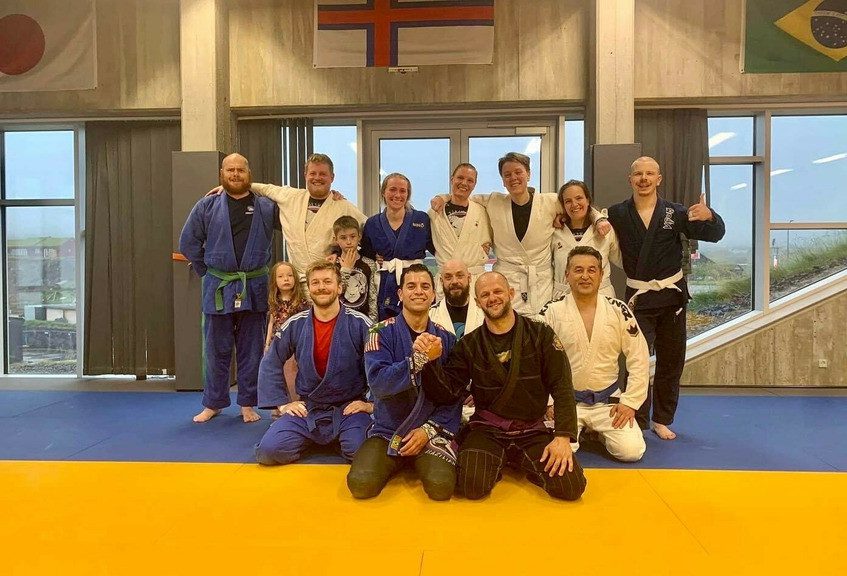
Where is the gym located?
The gym is located in Tórshavn, the capital city of the Faroe Islands.
How many people train there?
We currently have approximately thirty members.
Is the gym growing – if so by how many new members each month or year?
Yes, the gym is growing but not in a linear way. Throughout the year, we grow by a small handful of people while some existing members might pause or cancel their memberships. All in all, we have a strong core community while membership ebbs and flows in a positive direction.
What are the highest and lowest belt grades training?
We have one purple belt, seven blue belts, and the rest are white.
When did the gym open?
In the summer of 2015.
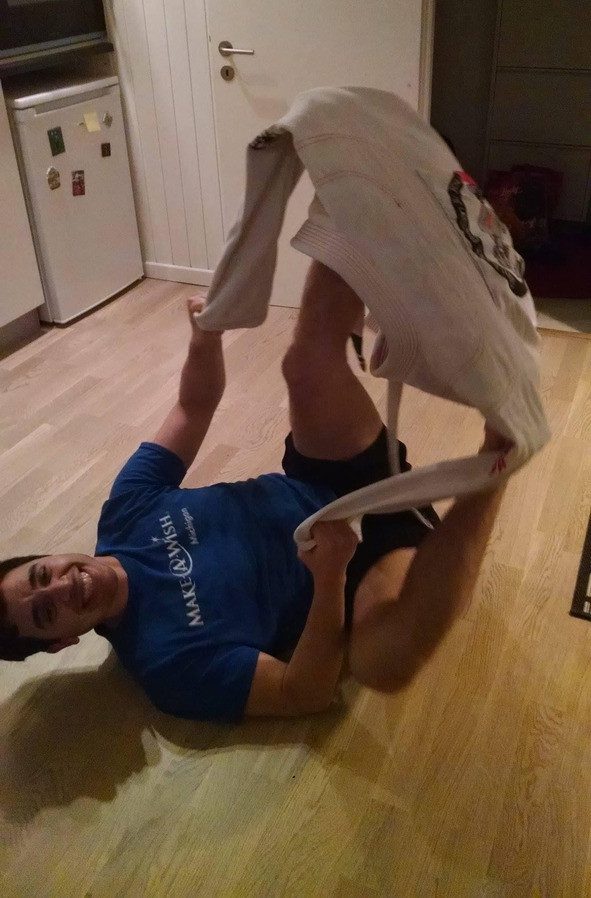
Some facts about you:
Name: Luis Antonio Pellecer Jr.
Age: 38
Academy: Tórshavn BJJ, Faroe Islands
Belt: Purple
Profession: Sales/Service Management & Landscaping
Years in BJJ: 14
Other martial arts: Muay Thai/Boxing
Currently living in: Iceland
Originally from: Michigan, USA
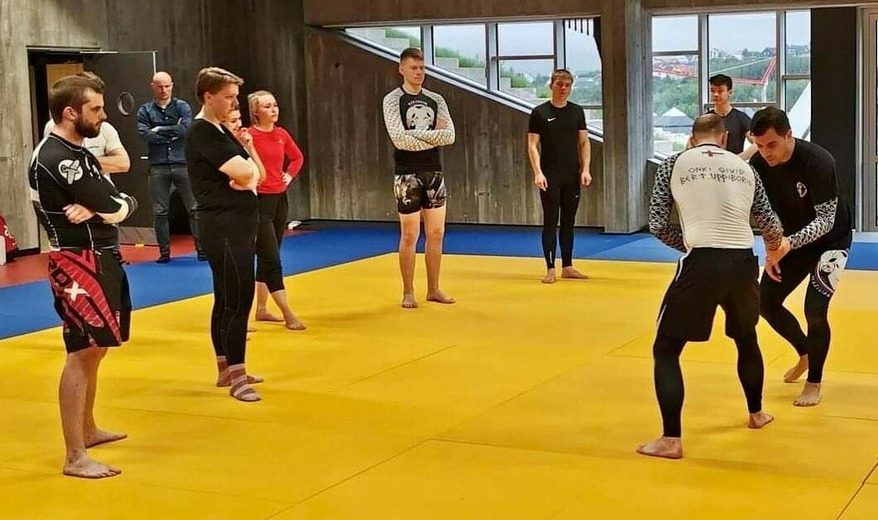
Please tell us the story of how the gym came into existence
I moved to the Faroe Islands as an early blue belt and quickly realized no one was training Brazilian Jiu-Jitsu. With no one to train with, I resorted to tying a gi onto a pillow and practicing guard work, but this style of training obviously got old quickly. I decided to begin advertising some BJJ 101 classes, and with the help of a local gym and the local judo club, Tórshavn BJJ was born.
Tell us about the people that train in Tórshavn BJJ, Faroe Islands – who are they?
Our club is made up of people from all walks of life, from teenagers who want to build their self-esteem to adults in their 50s who want to work on fitness, flexibility, and self-defense.
Why do they train?
I can confidently say the primary reasons our members train are: self-defense, mental health, and community. BJJ is world-famous for its practicality and efficiency for self-defense, but something the BJJ community had known for a long time is how it can play a transformative role with mental health. We have members who discovered BJJ to be therapeutic for their anxiety, depression, ADD/ADHD, and PTSD. Whether it stems from the discipline, fitness, confidence, community, or some combination of these factors, our members have found BJJ positively impacts their lives in various areas of life.
What are some of the challenges of running a BJJ gym in general, and in your area specifically?
Of course there are the practical challenges of running this sort of operation e.g. finding a system to handle membership fees, creating and adjusting the training schedule to fit most people’s needs, etc. However, the biggest challenge for our club has been breaking through social preconceptions of which sports are appropriate/acceptable and which are not. The Faroe Islands is a fantastic place for many reasons, but it has been isolated from the outside world until relatively recently. So when locals see adults rolling around on the floor in compromising positions, self-defense and fitness are not the first things to pop in their heads. This matter is combined with the fact that the Faroes are heavily invested, socially and financially, in their most popular sports, namely Football and Handball. So yeah, it has been a slow process for us, but we are making progress with gaining headspace in Faroese sports consciousness.
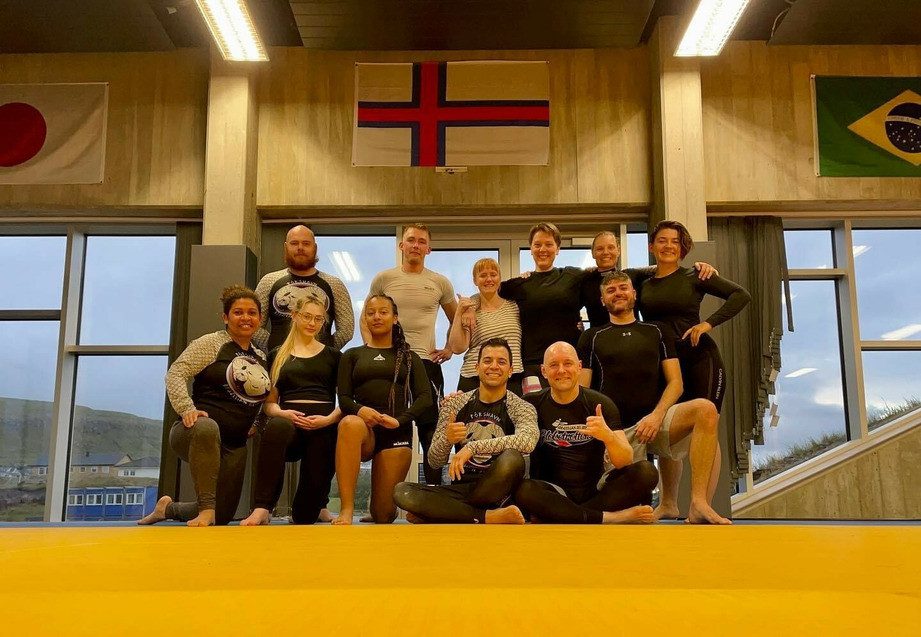
How do you see the future for BJJ, Faroe Islands?
In the near future, we hope to get recognition by the Faroese Sports Authority which would provide our club, and the sport throughout the country, with funds and greater legitimacy in the eyes of the public.
What’s the best thing about the gym?
The best thing about our gym is the community of kind people who are always willing and ready to choke out a friend in need.
What would you recommend Globetrotters to see in your area apart from the inside of Tórshavn BJJ, Faroe Islands?
We have some wild and magnificent nature in the Faroes, so I would recommend renting a car and spending a couple days exploring the beautiful fjords, waterfalls, mountain hikes, and ocean views. But make sure to leave time & room for the local food, especially the fermented meat! Oh, and also important, book your hotel & restaurant reservations MONTHS in advance if possible. This is a tiny country, so things fill-up quickly, especially during tourist season. Either way, enjoy!
—-
Thanks for sharing! If you’d like to visit Tórshavn BJJ, Faroe Islands you can find them here.
Featured traveller: Volkert Doop – BJJ Globetrotters
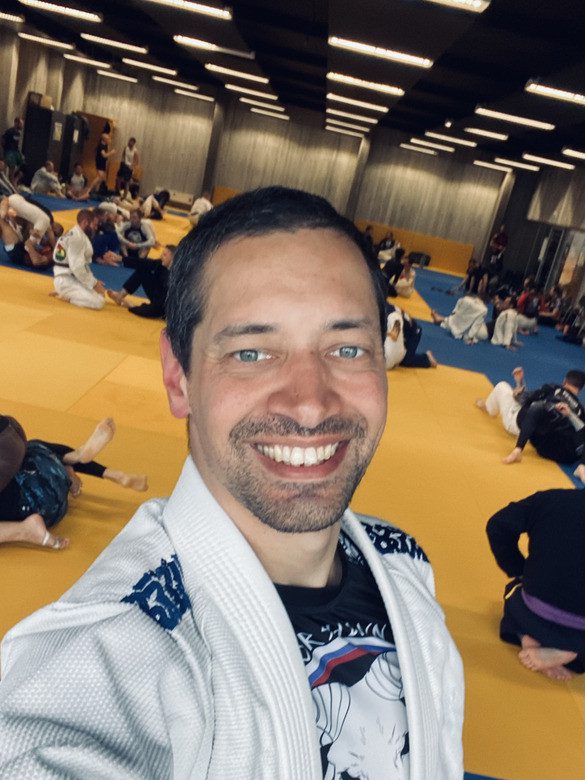
Volkert Doop – BJJ Globetrotters Camp in Faroe Islands
Age: 39
Belt: White
Profession: Project Manager
How many years in BJJ: Almost three years
Other martial arts: Four classes of Myanmar Lethwei boxing back in 2017
Where do you live: The Hague, Netherlands
Where are you from: The Hague, Netherlands
Other fun or curious information you would like to share: This year I fought my first two competitions.
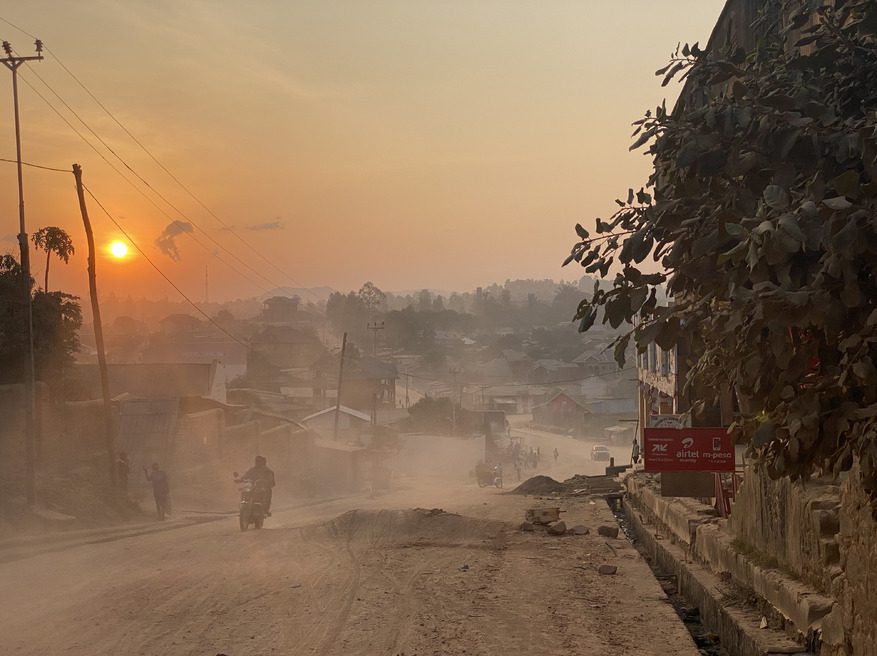
Tell us what inspired you to travel and train?
After starting to train BJJ in January 2020, I immediately found BJJ Globetrotters online, and I felt that this could be my thing. Travelling and learning how to shoulder roll and perhaps even some arm bars while traveling to locations I’d never been to, sounded way too exciting. That month I immediately booked the Arizona camp for March 2020 and the following Zen camp.
As we all know, 2020 was a tough time for travel-hungry pajama-fighters and the Arizona camp was off. I had a tough time getting through those first few lockdowns. I had no idea about basic techniques, and suddenly I wondered if this was the right thing to have invested my money in and committed my time to. Though during the following Zen camp I realized how I was going to try and progress through Jiu Jitsu: slowly and steadily, while enjoying the scenery.
Tell us about your most recent travel and your upcoming travel – where have you been and where are you going?
This year my calendar bulged with travel. I had my third (Iceland), fourth (Faroe Islands), and soon my fifth camp (Zen). I travelled a couple of weekends to Rome, Berlin (shout out to Jack!), Switzerland, and the UK. And work travel to Burundi, Rwanda, DRC and Ethiopia.
In November I plan on travelling to Goma, DRC. There is no BJJ there, but the local boxing champ invited me into his gym. Apparently also some Congolese judo guys have volunteered to teach me some takedowns.
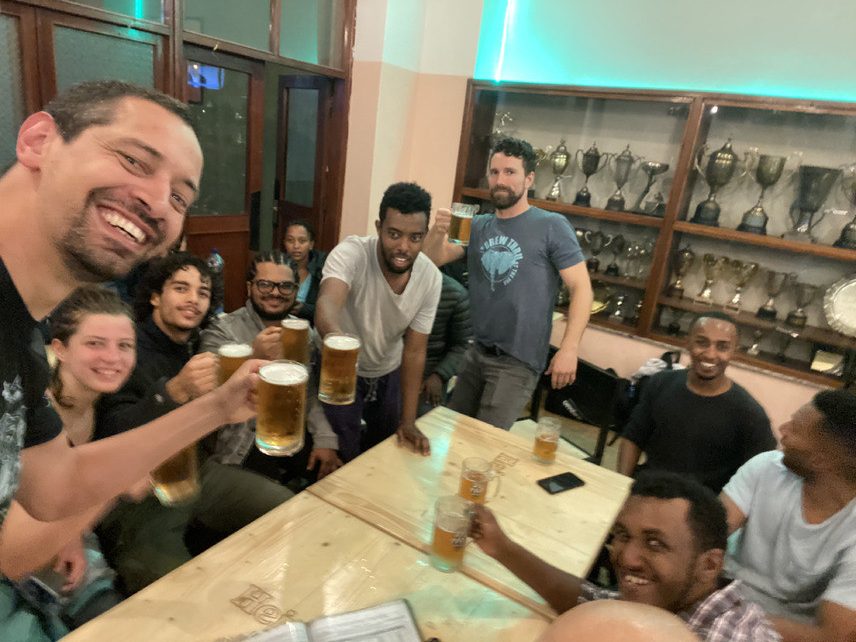
Volkert Doop – BJJ Globetrotters
What are the things you enjoy about travelling?
Ever since I was a teenager I’ve been fascinated about languages, cultures, and travelling. Now I’ve visited more than 60 countries and have lived in more than half a dozen. Many of the places I visited and lived in were touched by violent conflict or raw dictatorships. I managed to visit Syria just before the war started there in 2011, and I lived in Sudan, Central African Republic and Congo, and visited places like South Sudan and Myanmar. Every place I visit provokes these questions about where I come from and how the world is organized. Wherever I travel, I try to experience a part of daily normal life, because even though the political situation can be chaotic, there is always some normality to be found which helps to bridge the gap between me as a visitor and me as a part of society.
Although I had never trained any martial arts, in many places I’ve experienced it as part of the local culture. Just like the Netherlands is known for its kickboxing, in Sudan there is a lively Nuba wrestling culture and there I attended some matches. In Kinshasa, I saw teenagers training boxing in the early morning on the streets. So when I visited Myanmar, this led me to also take up some classes of Lethwei boxing. Without being able to understand a single spoken word, I trained along and I got a sense of the kind of discipline it would take to become any good at that sport.
Can you give us some examples of experiences you had that makes it worth traveling and training?
Whenever I now travel, I try to find a local gym. Since I travel to rather far-flung places, this isn’t always easy. Though this July when I was in Addis Ababa, Ethiopia, I found KAO BJJ, the only place to train Jiu Jitsu in Ethiopia. Being able to just join in and feeling the same excitement as in other classes at home or at the camps is so rewarding. The familiarity of Jiu Jitsu, while being far away from home, is perhaps for me one of the great things about travelling and Jiu Jitsu. And afterwards we could just sit down, break down sparring sessions, talk upcoming matches and just general weird Jiu Jitsu stuff over Ethiopian beer and Italian pizza.
Also having been part of the first Faroe Islands camp was a great experience. Not only were we, as humble visitors, excited, but the genuine excitement of the local BJJ community was palpable. I guess there is something about the traveling Jiu Jitsu community which doesn’t only make traveling exciting for the visitor, but also for the host.
Exchanging techniques from home and blending in those from abroad… for me it connects me both to my roots, where I come from, as well as to the town, the country, and the people that I’m visiting.
What has so far been the most surprising experience for you when traveling?
Last month, when visiting a friend in Woking, UK, I walked into the local gym. To my surprise, fellow Globetrotter Seb opened the door! Is it that the world has gotten very small, or is it that BJJ Globetrotters has gotten very big?!
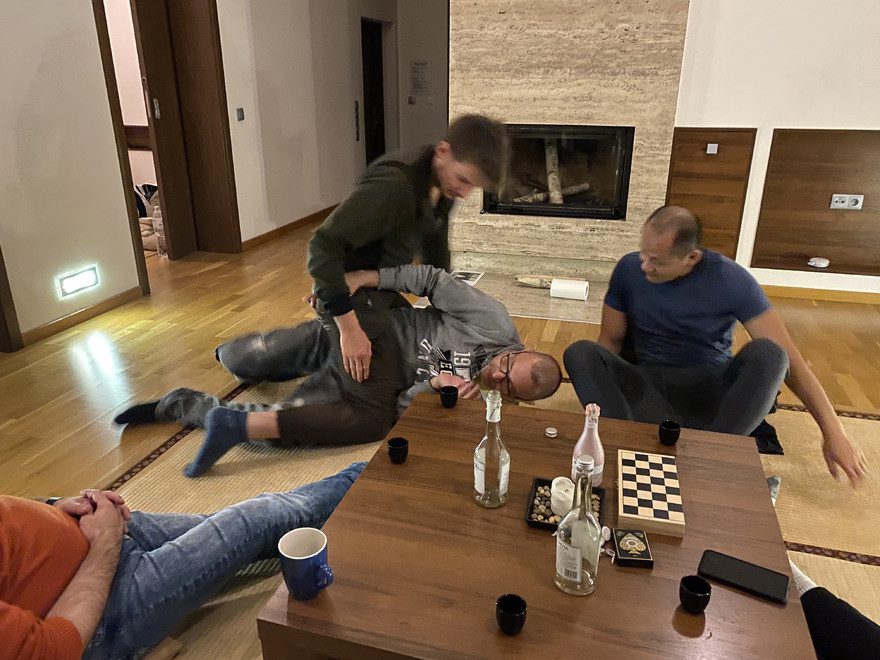
Volkert Doop – BJJ Globetrotters
Are you a budget traveller – and if so how do you plan for a cheap trip?
My best advice is to make a lot of friends. Both at the camps, but also wherever else you can. It has allowed me to visit so many places I otherwise would have never been able to visit. And of course, I try to pay it forward. So please come and visit me in The Hague!
If you were to pass on travel advice to your fellow Globetrotters, what would it be?
Follow your curiosity and don’t hesitate to reach out to any local gyms. So far I’ve only had good experiences.
And if you happen to visit gyms which have difficult access to BJJ materials, bring them with you! In Ethiopia for the new students, they really had a tough time getting enough training materials: gis, white belts (the pieces of fabric), and higher belts (the persons).
